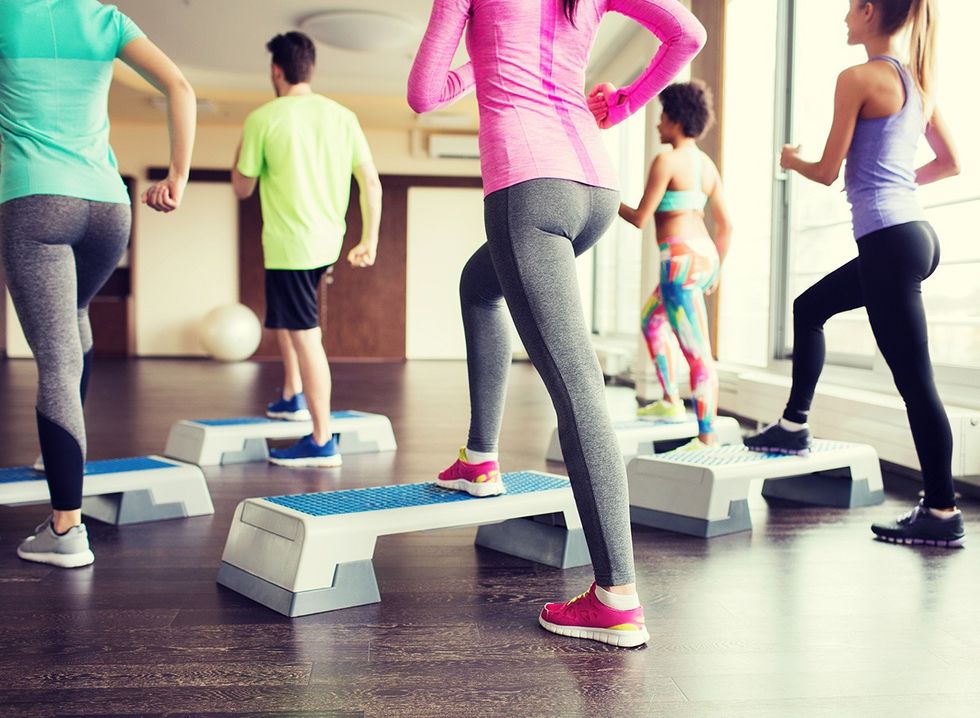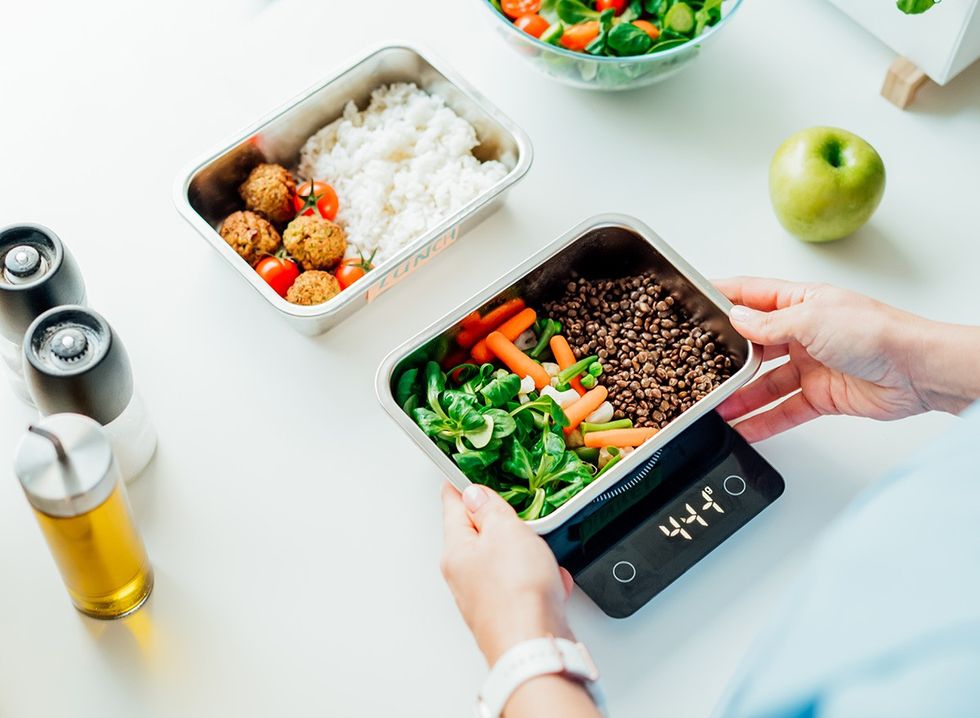There are many ways to burn calories outside of traditional exercise methods. Simple household maintenance jobs and yard work can help you burn fat, get fit, and encourage an active lifestyle. Chores within the home and outside might not seem like a workout, but you’d be surprised how many calories are burned performing tasks such as weeding or painting. Here are 10 simple household chores that can help with weight loss in your 50s.
Mowing the Lawn

Mowing the lawn is a great way to get exercise and burn calories. “Use manual clippers, shears and mowers instead of tools that plug into an outlet,” Christina Chapski, EdD, AT, ATC, tells Henry Ford Health. “Using a traditional push mower, for example, requires you to use your legs, upper body strength and core. That's not the case with power mowers, or the type that you sit on and steer.”
Painting Walls

You can burn 306 calories an hour with house painting—so for a four hour job, that’s a whopping 1200 calories. According to Harvard Health, just remodeling or putting paper up can burn over 200 calories an hour.
Shoveling Snow

You can burn over 266 calories an hour shoveling snow, but be careful if you have a heart condition, experts warn. “People who have a medical condition like high blood pressure or a medical history of heart disease are at increased risk for a heart attack when performing strenuous exercise,” says the CDC. “So, do not just pick up a shovel and start throwing snow.”
Putting Things Away

Putting things away and tidying up can help with fat loss. “Don't be afraid to really scrub down those surfaces and tiles or run the vacuum around the house,” fitness expert Joe Mitton tells Homeaglow. “When it comes to burning more calories we need to think about the bigger muscle groups and more difficult household cleaning tasks. Rather than bending over to clean something, squat down and hold the squat.”
Trimming Hedges

Trimming hedges can help burn fat. “Even the less strenuous forms of garden upkeep - weeding, trimming, raking - can burn off about 300 calories an hour,” says Texas A&M University Agrilife Extension. “Spading, lifting, tilling, and raking can improve muscle tone and strength.”
Weeding Plants

Weeding is a strenuous activity that burns calories. “Treat gardening like any workout: Stretch for 10 minutes, then alternate light activities with heavier ones,” Chapski says. “You might rake for a little while, then dig a few holes, then prune. Cool down for 10 to 15 minutes—perhaps by snipping flowers or picking vegetables--and you’re done! Just keep in mind that gardening requires endurance, strength and flexibility, so it’s important to build up gradually.”
Raking Leaves

If you’re blessed to live with plenty of trees, chances are you’re raking leaves frequently. “Raking and disposing of leaves is more than a chore. It can be a very demanding exercise,” says the University of Rochester Medical Center. “Although exercise is good for you, this workout can be full of repetitive motions… Don't bend at the waist to lift heavy items, such as leaves, bags, or equipment. Instead, bend at the knees and keep your back straight.”
Washing Windows

Washing windows is no joke, especially windows which are big enough for you to really have to reach. You can burn up to 126 calories an hour scrubbing, washing, and drying windows. Bonus points if you have to climb up and down a ladder!
Cleaning the Kitchen

Cleaning the kitchen is tough—there is usually so much to do between the oven and fridge, just to begin with. “If you want to burn the most calories cleaning your house, the kitchen is your best bet,” Homeaglow researchers say. “Our results show that the cleaners in our experiment averaged burning 276 calories per kitchen — which is equivalent to jogging for just under 40 mins straight.”
Cleaning the Floors

Cleaning the floors burns lots of calories. “Incorporating more squatting or lunging type movements into your cleaning, trying to stay moving the whole time, and making additional trips up and down the stairs,” Physiotherapist Dr. Dave Candy tells Homeaglow. “Additionally, cleaning more often rather than waiting until the house gets messy can help increase the frequency of your "workouts" while also keeping your home looking tidier.” And if you enjoyed this article, take advantage of these 15 Quick Ways to Lose Body Fat Percentage in a Week.














 Shutterstock
Shutterstock Shutterstock
Shutterstock Shutterstock
Shutterstock Shutterstock
Shutterstock Shutterstock
Shutterstock



 Shutterstock
Shutterstock Shutterstock
Shutterstock Shutterstock
Shutterstock Shutterstock
Shutterstock Shutterstock
Shutterstock Shutterstock
Shutterstock Shutterstock
Shutterstock Shutterstock
Shutterstock Shutterstock
Shutterstock

 I'm a Nutritionist and These 9 High-Protein Snacks Keep My Clients Full While Losing 50 Pounds
I'm a Nutritionist and These 9 High-Protein Snacks Keep My Clients Full While Losing 50 Pounds
 Shutterstock
Shutterstock 2. Processed FoodsShutterstock
2. Processed FoodsShutterstock Shutterstock
Shutterstock Shutterstock/Prostock-studio
Shutterstock/Prostock-studio Shutterstock
Shutterstock Pro TipsShutterstock
Pro TipsShutterstock Shutterstock
Shutterstock Shutterstock
Shutterstock Shutterstock
Shutterstock Shutterstock
Shutterstock Don’t Drink as Much AlcoholShutterstock
Don’t Drink as Much AlcoholShutterstock Most Women on GLP-1s Are Making a Few Common MistakesShutterstock
Most Women on GLP-1s Are Making a Few Common MistakesShutterstock Soda and Sugary DrinksShutterstock
Soda and Sugary DrinksShutterstock Shutterstock
Shutterstock Eat BreakfastShutterstock
Eat BreakfastShutterstock And Improve Insulin SensitivityShutterstock
And Improve Insulin SensitivityShutterstock Belly Flab Strip Tip: Sugar and Fat Calories Leave Its Mark on Your BodyShutterstock
Belly Flab Strip Tip: Sugar and Fat Calories Leave Its Mark on Your BodyShutterstock Shutterstock
Shutterstock The Drugs Mimic the GLP-1 Hormone Naturally Produced by the BodyShutterstock
The Drugs Mimic the GLP-1 Hormone Naturally Produced by the BodyShutterstock 3. Deep-Fried ItemsShutterstock
3. Deep-Fried ItemsShutterstock